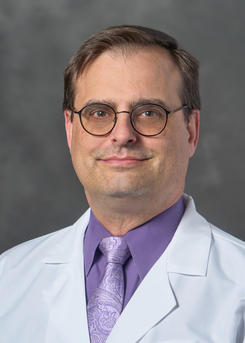Provider Spotlight: Dr. Sean Drake, Henry Ford Care at Home

When Dr. Sean Drake was first introduced to the Henry Ford Care at Home program, he was working in a hospital clinic that had the goal of avoiding hospitalizations — making the hospital care at home program “a natural fit.”
In the clinic, “We were managing patients remotely using telemedicine,” he explains, which made the telehealth aspect of hospital at home an easy transition.
He quickly found that the approach was doubly rewarding, for both the patients and the health system. “The patients are grateful for the care,” he says. “They’re getting the same level of care in their own home, eating their own food, and able to sleep in their own bed.” He notes that at the same time, the providers have the satisfaction of feeling good about helping people.
He adds, “It’s a good thing to do for the health system. I’m taking care of less complicated patients so that the system can free up space for more complicated patients from outside hospitals. Our hospitals tend to run at or over capacity, and we’re a referral center for things like oncology, neuroscience and transplants. By doing this, I free up a bed for a patient to transfer to Henry Ford for more specialized care.”
Building confidence in a new concept
Because hospital at home is still relatively new as a model of healthcare delivery, Dr. Drake explains that it sometimes causes hesitation for patients when they first hear about it. “This is a new concept, and despite explaining it, sometimes people are a little more comfortable going into the hospital rather than staying at home,” he notes. “But, for those who do qualify and have an appropriate diagnosis and accept admission, it’s definitely the preferred way to receive this kind of care.”
He also finds that although the technology may feel a bit daunting to some people, it doesn’t create a barrier for patients. “The nice thing with this technology is that the patient doesn’t need to even know how to turn on their phone. They don’t have to be technologically savvy,” he says. Nurses use the equipment to perform collaborative evaluations, including the use of video guided by the physician to remotely assist with physical assessments. They also set up the telehealth sessions with the doctor.
Another benefit of this, he says, is the “house call” nature of the virtual visits: “I’m seeing inside of peoples’ homes, and you gain a lot of insight when you do that.”
The key to the success of this hybrid in-person and virtual care delivery: the nurses. Because of the close-knit team involved with the program, Dr. Drake feels he’s had a chance to get to know the nurses individually, unlike in the hospital, where his interactions were always with different nurses. “I’d work on the service for two weeks, be gone for two months, go back, and it would be an all-new crew,” he explains. In contrast, “It’s nice working together with this group of nurses, we’ve been working together for a while, and I know I can trust their assessment.”
An easy remote workflow
Dr. Drake shares that these factors, along with the program’s design, allow for seamless care delivery. Each day, the Acute Care Registered Nurses (ACRNs) in the field perform their assessments and record heart and lung sounds using the advanced telehealth equipment. “The nurses do a great job of presenting cases to us,” he says. “Before I log in to a virtual visit, I can listen to the heart and lungs, review the vitals, the labs that have been drawn since we last met and the medication list. It’s quick and easy.”
To ensure quality care outcomes, “We set a plan at the beginning of the hospitalization as to what we’re trying to accomplish, and then every day is just evaluating how we’re progressing in that plan towards the goals.” Built into that process, he notes, are carefully designed clinical workflows for addressing any unexpected escalations in the level of care needed. “Things can happen, but we have very good processes in place to recognize those things. We have a really good team.”
Dr. Drake continues to see patients in the outpatient clinic alongside his role as a Care at Home hospitalist. “I really enjoy this kind of model,” he says. “It’s not hard work, but it’s rewarding work.”
